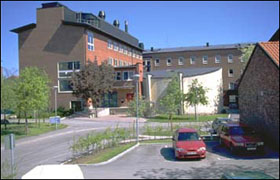General information
Architect: Ture Ryberg (1953) O. Hidemark, G. Månsson, L. Olsson (1970) M. Hallén (1997)
Flight Physiology which was the building's original name and department was completed in 1953.
Back round
The origin of the first expansion was a floor plan and the centrifuge building was that in Sweden in the late 1930s, especially for the aeromedical part, a strong need for intensified research activities emerged. Several study trips provided clear evidence that the resources within the country were not sufficient to satisfy the requirement for safety and efficiency when flying.
Extension
The aeromedical extension is designed as a wing building for the Department of Physiology in the north-west direction. The cylindrical building that houses the centrifuge facility is connected to the extension. In the aeromedical extension, it was also possible to accommodate a negative pressure chamber. Construction work began in 1951, and the extension was completed in 1953.
Design and manufacturing work on both the centrifuge and pressure chamber facility was ongoing at the same time as the construction work. The pressure chamber plant was delivered in 1954 so that. Human trials could take place at the end of 1954. At that time there were only two centrifuge facilities in Europe. For studies of test object reactions under g-load.
It records various physiological and psychological processes.
The negative pressure chamber is dimensioned for vacuum, the overpressure chamber for a working pressure of 15 kg/cm2 corresponding to the pressure at 150 meters level and has a common lock. It is primarily intended for the treatment of decompression sickness.
In 1970, another two-story addition was completed for aviation medicine. Architects were O. Hidemark, G. Månsson and L. Olsson.
In 1997, the building was fully equipped and the centrifuge facility was modernized to meet future demands for modern and flexible research premises. The architect was Mats Hallén at Alsenarkitekter.
